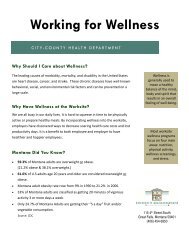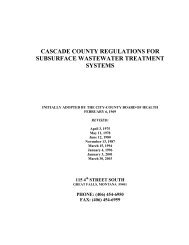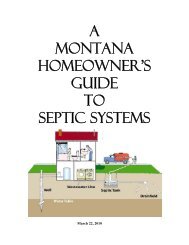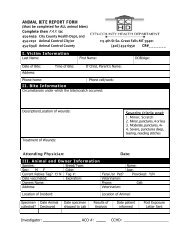Historic Dates and Events Related to Vaccines and Immunization
Historic Dates and Events Related to Vaccines and Immunization
Historic Dates and Events Related to Vaccines and Immunization
Create successful ePaper yourself
Turn your PDF publications into a flip-book with our unique Google optimized e-Paper software.
<strong>His<strong>to</strong>ric</strong> <strong>Dates</strong> <strong>and</strong> <strong>Events</strong> <strong>Related</strong> <strong>to</strong> <strong>Vaccines</strong> <strong>and</strong> <strong>Immunization</strong><br />
grown in duck-embryo culture (Meruvax by Merck); <strong>and</strong> Cendehill strain grown in rabbit-kidney culture (Cendevax by RIT-SKF, <strong>and</strong><br />
Lirubel <strong>and</strong> Lirutrin by Dow).<br />
1968 - 1969 The "Hong Kong" influenza p<strong>and</strong>emic, caused by an H3N2 influenza virus, resulted in roughly 34,000 deaths in the U.S.<br />
1968 A second live, further attenuated measles virus vaccine (Attenuvax by Merck, based on the Moraten strain, derived from the Edmons<strong>to</strong>n<br />
strain) was licensed.<br />
1967 The Global Smallpox Eradication Program was launched by WHO. During the first year of the program, 44 countries, 31 of which had<br />
endemic smallpox, reported 217,218 cases.<br />
Dec 28, 1967<br />
Mumps virus vaccine live (MumpsVax by Merck) was licensed. The vaccine was developed by Maurice Hilleman who isolated a wild<br />
type virus from his daughter, Jeryl Lynn, who was recovering from mumps. It became known as the Jeryl Lynn strain of mumps virus.<br />
1966 The World Health Assembly called for global smallpox eradication.<br />
1966 CDC announced the first national measles eradication campaign. Within 2 years, measles incidence had decreased by more than 90%<br />
compared with prevaccine-era levels.<br />
1966 The rubella virus was attenuated by Paul Parkman <strong>and</strong> Harry Meyer, Jr.<br />
1965 Bifurcated needle for smallpox vaccine introduced<br />
1965 Live, further attenuated measles virus vaccine (Lirugen by Pitman Moore-Dow based on the Schwarz strain, derived from the<br />
Edmons<strong>to</strong>n strain) was licensed in the U.S. The recommended age for routine administration was changed from 9 <strong>to</strong> 12 months of age.<br />
1964 A rubella epidemic swept the U.S. resulting in 12.5 million cases of rubella infection, an estimated 20,000 newborns with congenital<br />
rubella syndrome (CRS), <strong>and</strong> excess fetal <strong>and</strong> neonatal deaths in the thous<strong>and</strong>s.<br />
1964 The <strong>Immunization</strong> Practices Advisory Committee (ACIP) <strong>to</strong> the U.S. Public Health Service was formed <strong>to</strong> review the recommended<br />
childhood immunization schedule <strong>and</strong> note changes in manufacturers' vaccine formulations, revise recommendations for the use of<br />
licensed vaccines, <strong>and</strong> make recommendations for newly licensed vaccines.<br />
June 25, 1963<br />
Trivalent oral polio vaccine was licensed. The vaccine development began in 1957 by Albert Sabin <strong>to</strong> improve upon the killed Salk<br />
vaccine.<br />
1963 The Federal <strong>Immunization</strong> Grant Program was established. The grants, authorized under section 317 of the Public Health Service Act,<br />
were made <strong>to</strong> states <strong>to</strong> provide funds <strong>to</strong> purchase vaccines <strong>and</strong> <strong>to</strong> support basic functions of an immunization program. The only<br />
vaccines available at the time were DTP, polio, <strong>and</strong> smallpox.<br />
Mar 21, 1963<br />
The first live virus measles vaccine (Rubeovax by Merck) was licensed. Other live virus measles vaccines were eventually licensed (M-<br />
Vac by Lederle, Pfizer-vax Measles-L by Pfizer, <strong>and</strong> generic vaccines by Lilly, Parke Davis, <strong>and</strong> Philips Roxane).<br />
1963 Inactivated measles vaccine (Pfizer-vax Measles-K by Pfizer <strong>and</strong> a generic vaccine by Lilly) were licensed in the U.S. These vaccines<br />
were eventually withdrawn from the U.S. market in 1967.<br />
1962 President John F. Kennedy signed the the Vaccination Assistance Act in<strong>to</strong> law. It allowed the CDC <strong>to</strong> support mass immunization<br />
campaigns <strong>and</strong> <strong>to</strong> initiate maintenance programs.<br />
Mar 27, 1962<br />
Oral polio vaccine type 3 was licensed in the U.S., as well as the trivalent product.<br />
1961 Oral polio vaccine types 1 <strong>and</strong> 2, developed by Dr. Albert Sabin <strong>and</strong> grown in monkey kidney cell culture, were licensed for use in the<br />
U.S.<br />
1957 - 1958 The "Asian" influenza p<strong>and</strong>emic, caused by an H2N2 influenza virus, resulted in an estimated 70,000 deaths in the U.S. alone.<br />
1955 The Polio Vaccination Assistance Act was enacted by Congress, the first federal involvement in immunization activities. It allowed<br />
Congress <strong>to</strong> appropriate funds <strong>to</strong> the Communicable Disease Center (later the Centers for Disease Control <strong>and</strong> Prevention) <strong>to</strong> help<br />
states <strong>and</strong> local communities acquire <strong>and</strong> administer vaccine.<br />
1955 The Cutter polio vaccine incident began on April 25, 1955, when polio was reported in a vaccine recipient. One day later, five more<br />
cases were reported. All cases had received vaccine produced by Cutter Labora<strong>to</strong>ries. Polio was reported in 94 vaccinees <strong>and</strong> in 166<br />
close contacts of vaccinees. On April 27, the Labora<strong>to</strong>ry of Biologics Control requested that Cutter Labora<strong>to</strong>ries recall all vaccine <strong>and</strong><br />
the company did so immediately. On May 7, the Surgeon General recommended that all polio vaccinations be suspended pending<br />
inspection of each manufacturing facility <strong>and</strong> thorough review of the procedures for testing vaccine safety. The investigation found that<br />
live polio virus had survived in two batches of vaccine produced by Cutter Labora<strong>to</strong>ries. In 1955, as a result of the Cutter Incident, the<br />
Labora<strong>to</strong>ry of Biologics Control was raised <strong>to</strong> division status within NIH, <strong>to</strong> strengthen <strong>and</strong> exp<strong>and</strong> its biologics control function. Largescale<br />
polio vaccinations resumed in the fall of 1955.<br />
Apr 12, 1955<br />
The first polio vaccine was licensed -- an inactivated poliovirus vaccine (IPV) pioneered by Dr. Jonas Salk.<br />
1954 The Nobel Prize in Medicine was awarded <strong>to</strong> John Enders, Thomas Weller, <strong>and</strong> Fredrick Robbins for their discovery of the ability of<br />
poliomyelitis viruses <strong>to</strong> grow in tissue cultures.<br />
1954 John Enders <strong>and</strong> Thomas Peebles isolated the measles virus in cell culture.<br />
http://www.immunize.org/timeline/[6/20/2013 5:22:19 PM]








